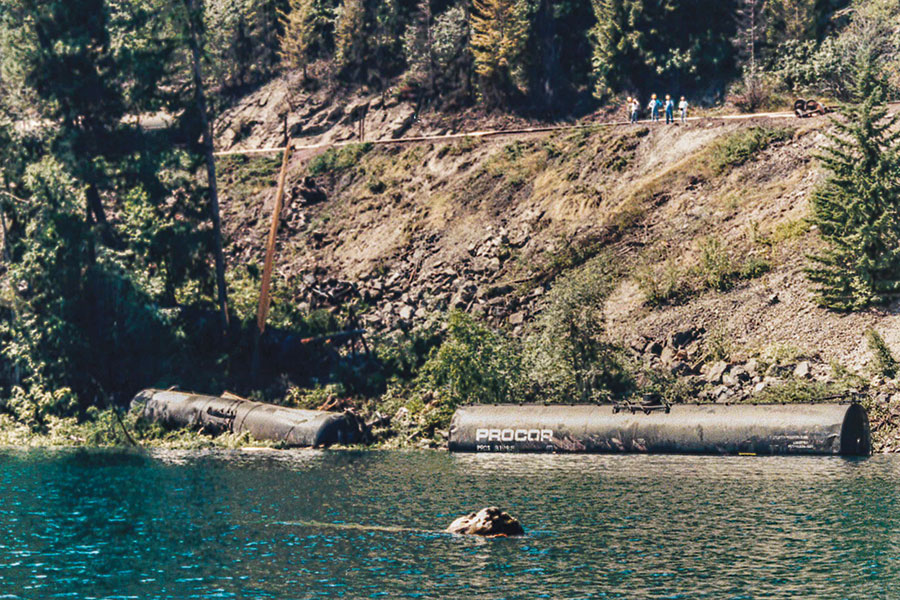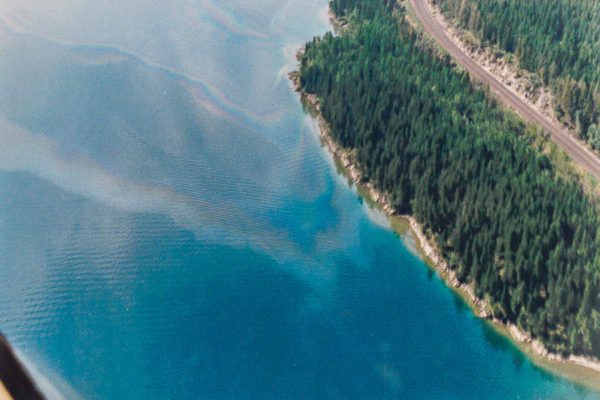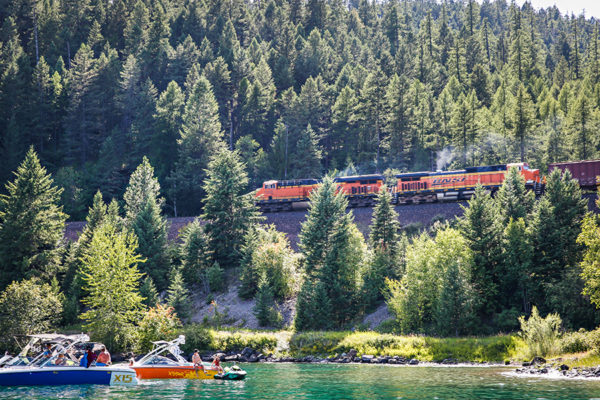Lessons From The Spill
Thirty years after a train derailed and spilled diesel fuel into Whitefish Lake, the railroad says it can handle hazardous materials safely, but conservation groups worry it could happen again
By Justin Franz
WHITEFISH — Charlie Abell has spent nearly all of his 80 years living along the shores of Whitefish Lake.
As a kid, he lived in a log home just feet from the water’s edge. In the 1970s, he and his wife bought a home near where the Whitefish River meets its namesake lake. His son even got married on the family boat in Mackinaw Bay. Abell said a lot has changed in those 80 years. There are more people on the water than ever, for one, and the fishing isn’t quite as good as it once was.
But plenty has remained the same. City Beach is still a popular spot to go for a dip on a hot summer day, Big Mountain still looms tall over the lake and trains still roll along the western edge, just as they have since 1904. Anywhere from 20 to 30 trains a day rumble past Abell’s house and twist and turn along the shore. From Abell’s living room, he can watch trains zip across the causeway at Mackinaw Bay, the very spot 30 years ago this summer where a Burlington Northern freight derailed and spilled between 20,000 and 25,000 gallons of diesel fuel into Whitefish Lake.
Boating around Mackinaw Bay or walking along the shore there, it’s hard to tell that a derailment ever happened. But conservation groups are worried that it could happen again, especially as crude oil from North Dakota’s Bakken region continues to be shipped to the Pacific Northwest by way of Glacier National Park and the Flathead Valley.
“It worries me,” Abell said. “I’d hate to see another spill happen.”
Abell was driving home from work on July 31, 1989, when he heard news on the radio that a train had derailed along Whitefish Lake. It was a Monday and Abell, who at the time worked as the manager at Whitefish Credit Union, had taken the afternoon off to help make sure City Beach was cleaned up following a weekend regatta. When Abell got home, he hopped in a boat with his son and headed to the derailment site, about a 10-minute trip from his house.
When the Abells arrived, they found that four tank cars had rolled down the steep embankment and into the lake.
“My first thought was, ‘What a mess,’ Abell said. “(We motored over to the tank cars) and you could see a tube on top of the tank that was squirting out a dark liquid.”
After surveying the scene, Abell said he went back to town to find more boaters to help throw absorbent pads that had been brought to the site soon after the derailment. A few hours later, Abell was back in Mackinaw Bay tossing the pads in hopes of sucking up as much of the spilled diesel fuel as possible. By then, containment booms were placed around the bay as well as at the mouth of the Whitefish River.
Abell and his son worked well into the evening to help keep the diesel fuel from spreading.
“It was dirty and hot,” he said. “(I remember being) tired and pissed off that my lake was messed up.”

The derailment was the result of a broken freight car center plate, part of the wheel assembly (known as trucks) that connects with the frame of the car. According to a newspaper account, 29 cars of the 100-car train freight derailed, with most of them piling up in a rock cut just south of Mackinaw Bay.
Within a few days, diesel fuel had spread to other parts of the lake and was washing up on the opposite shore. The lake and public spaces along it were closed, and then Montana Gov. Stan Stephens declared a state of emergency. During a helicopter tour of the area two days after the derailment, the governor reported seeing the rainbow sheen of a thin slick across half the lake.
“It’s awful,” eastshore resident Dean Olafson told the Associated Press. “We’ve been mopping all morning and the winds changed and now it’s just come back in.”
Two days after the derailment, the Montana Department of Environmental Quality (DEQ) took water samples from Whitefish residences that received their water from the lake. Most showed no contamination, but several had low levels of benzene, toluene, ethylbenzene and xylene, all compounds found in petroleum. However, none of the samples had contaminant levels that would prohibit it from being used as drinking water.
The railroad was criticized by locals for what was described in the press at the time as a “halfhearted” response.
Burlington Northern hired contractors who worked with the DEQ to clean up the spill, and in the late summer and early fall of 1989, contaminated soil was excavated from Mackinaw Bay. Although a sheen could be seen across the lake, most of the 20,000 to 25,000 gallons that spilled remained in the area of Mackinaw Bay.
But the ramifications persisted long afterward. About 20 years after the derailment, Abell boated over to Mackinaw Bay to go deer hunting on nearby family land. When he got off his boat and stepped on to the shore, he looked down to see a sheen of diesel.
“I could see the remnants of diesel fuel oozing up around my boots,” he said.
The Whitefish Lake Institute, a science and education organization dedicated to protecting the lake, collected soil samples that contained petroleum hydrocarbons. In 2012, Burlington Northern Railroad’s successor, BNSF Railway, worked with the U.S. Environmental Protection Agency (EPA) to dredge up contaminated sediments from Mackinaw Bay that were missed during the initial cleanup in 1989. EPA officials said the dredging reduced the petroleum concentrations in the sediments of Mackinaw Bay by 97.3 percent.
Mackinaw Bay is not the only contamination the railroad has had to deal with in Whitefish. BNSF has been working with the EPA and DEQ for years to clean up the fuel-soaked land in and around the Whitefish rail yard where diesel locomotives were maintained and fueled for decades. In 2013, the railroad completed a four-year environmental cleanup of the Whitefish River, which included the removal of 26,000 cubic yards of contaminated sediment along the waterway. This week, BNSF crews were back on the river after the DEQ received a report of a petroleum sheen in the river.
Thirty years after the spill, local conservation groups worry about another hazardous materials spill, especially now that crude oil from North Dakota’s Bakken region is regularly shipped through Northwest Montana.
In 2005, North Dakota produced 98,000 barrels of oil per day. By 2017, it was producing 1.1 million barrels per day. The sudden increase in production, and a lack of pipeline availability at the time, meant producers began to ship more oil by rail than ever before. Under a federal provision called the “common carrier” obligation, railroads are required to transport any material, including hazardous ones.
According to the Association of American Railroads, oil shipments out of the Bakken peaked in 2014, when more than 800,000 barrels of oil were loaded daily. By late 2018, that had dropped to about 300,000 barrels of crude a day.
In 2014, about a dozen oil trains went through the Flathead Valley every week. According to BNSF, in 2019, anywhere from five to 10 loaded oil trains pass through the valley on a weekly basis.
The movement of oil by rail made headlines in 2013 and 2014 following a series of explosive oil train derailments across North America. The most destructive derailment happened in July 2013 when an oil train derailed and exploded in the town of Lac-Mégantic, Quebec, killing 47 people and leveling more than 30 buildings. More than 1.6 million gallons of fuel were released from the wreck. Much of the oil burned, but some seeped into the ground and the nearby Chaudière River. A provincial government report in 2016 found an “unprecedented” spike in fish deformities in the Chaudière following the spill.

Dave Hadden, the executive director of Headwaters Montana, said an oil train derailment along the Middle Fork Flathead River or Whitefish Lake could have devastating impacts on the environment and the economy. Hadden has recently been involved in a new group called Oil Safe Flathead, a coalition of local shareholders trying to raise awareness about the movement of oil through the region.
Hadden said he believes the public should be more involved with discussions about how to safeguard the movement of oil through its community and how to respond if a spill were to ever happen.
“We think the Flathead Valley is a special place and we want to protect it,” Hadden said. “We’re not trying to stop the shipment of hazardous materials by rail, but we think the public has a right to be involved in a discussion about how to make these shipments as safe as possible.”
Officials with BNSF Railway said they are doing everything they can to ensure that every shipment of hazardous materials arrives to its destination without incident. In the last five years, BNSF has invested more than $880 million in its infrastructure across Montana. It also installed additional freight car defect detectors in Northwest Montana that can identify a problem with a passing train and warn the engineer to stop before a derailment.
Since the Lac-Mégantic derailment in 2013, Canadian and U.S. government regulators and the railroad industry have also implemented more stringent rules on how hazardous material is moved by rail. The industry is also using tougher tank cars; the DOT-111 car — the same type that failed in the Lac-Mégantic — is no longer used to haul crude oil.
“Since (the 1989) incident and in particular over the past five years, BNSF and the rail industry have taken specific actions to further reduce the risk of moving hazardous materials,” spokesperson Maia LaSalle wrote in an email to the Beacon. “BNSF’s strong safety record reflects our continuing efforts. Today, 99.999 percent of hazardous materials shipments by BNSF arrive to its destination without a release.”
BNSF officials said the company is prepared should a derailment result in a spill of crude oil. The railroad has crafted a geographic response plan specific to the Flathead River Basin in coordination with the EPA. LaSalle said the railroad has stockpiled equipment, including absorbent materials and thousands of feet of containment boom, in Whitefish and the Flathead River Basin. BNSF also maintains contracts with multiple oil spill response organizations approved by the U.S. Coast Guard that have even more materials to respond to a spill should local resources be exhausted.
BNSF has also conducted a number of oil spill training drills with local first responders on Whitefish and Flathead lakes and in the Middle Fork Flathead River along the southern edge of Glacier National Park. Hadden said he is particularly concerned about a spill in the Middle Fork, especially when the river is running fast and high.

“The goal of BNSF is to prevent every accident, understanding that we must also prepare for the unlikely event of a derailment,” LaSalle said.
Onno Wieringa founded Glacier Raft Co. in 1976 and has been working and playing on the Middle Fork almost his entire life. He’s also on the board of directors for the Flathead Lakers, a nonprofit dedicated to clean water in the region, and has taken a particular interest in the movement of oil by rail. Wieringa said people like him are passionate about protecting their beloved waters and want to make sure companies like BNSF do everything they can to prevent a spill.
“Part of the fabric of life here in Montana is the quality of our spaces, and clean water is one of the reasons so many of us love it here,” he said. “(We have to protect it from) anything that could change that, be it aquatic invasive species or crude oil. We have to keep these spaces great for our kids and our kids’ kids.”
Abell agrees. On a recent afternoon, Abell cruised across Whitefish Lake toward Mackinaw Bay in his pontoon and talked about the derailment 30 years earlier. Abell said years ago, there used to be a huge mayfly hatch that would attract westslope cutthroat trout, making the bay an ideal fishing hole, but it hasn’t been as good in recent years. It’s unclear if the contamination had anything to do with that.
Regardless, Mackinaw Bay remains an ideal spot to drop a line or take a dip. Abell wants to keep it that way.
“The railroads and the regulators need to make damn sure those tracks are in good shape,” Abell said. “We want to make sure a spill never happens again.”